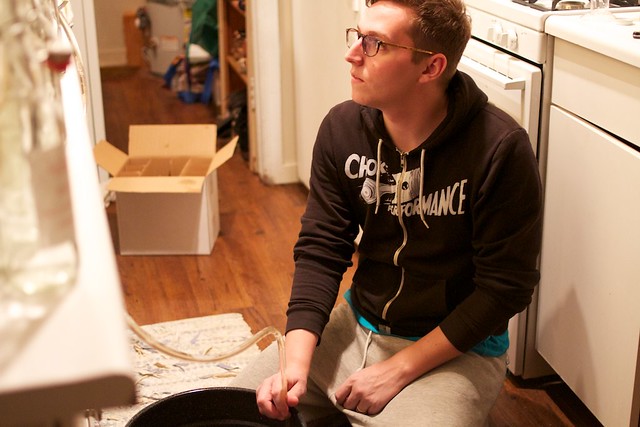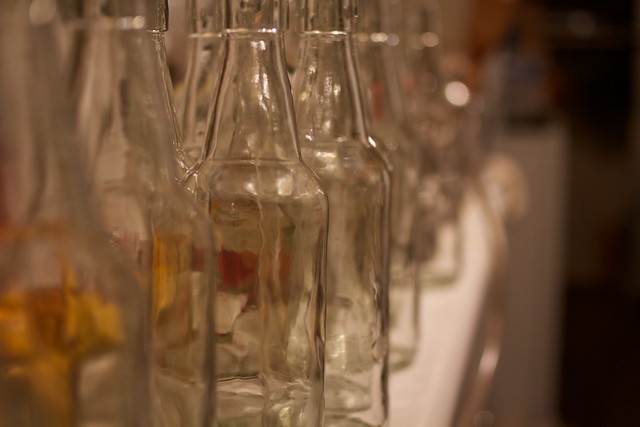Here is the recipe in bold for posterity, and I'll interject with some explanations throughout.
1-7-2011
4.75 gal Apple Juice
3.75 lbs white sugar
1 packet Champagne yeast
Potential Alcohol 11%
Cloudy orange coloring.
The potential alcohol is measured using a tool called a hydrometer. A hydrometer measures the gravity of a liquid in relation to the gravity of water. In lay-mans terms, water is measured as zero on a hydrometer, sugar adds density to the mixture, which the yeast will eat and turn into alcohol. So in this case my initial reading told me that I had a gravity of 1.081 or 11% potential alc. If the yeast eats all of the sugar, I would end up with an actual 11% alc. content cider.
Within 24 hrs a thick Krausen appeared, after cleaning the airlock a vigorous bubbling started within 72 hrs.
Krausen is the foam that erupts out of a just started batch of cider or beer. Unfortuneately I didn't get a picture of this ciders krausen, but here is someone elses:

(Photo from the Phillyist)
1/30/2011
First Racking
Potential alc.= 1%
therefore actual alc.= 10%
Significant Calrifying,moderate bubbling, strong apple scent from airlock
When brewing, the dead yeast and plant matter sinks to the bottom of the carboy. This gunk is called Lees. This is why I started with a cloudy mixture and over time it naturally clarifies. If a brew is left too long on the lees it can acquire what I've seen described on some websites as a "fecal taste". Gross. Racking is the process of moving the good stuff off of the lees into another clean container. Since all of the lees have now settled nicely on the bottom of the carboy it would be counterproductive to just pour out the cider so you have to remove it in such a way that doesn't disturb anything.
Racking when it comes down to it is just like siphoning gas. One hose goes from the first carboy into another, some sucking action, and everything transfers over nice and easy.



2/16/2011
Second Racking / Bottling
Potential Alc. = .5%
Actual alc. =~11%
added 1 cup corn sugar and 1 cup water for back carbonation
approx. 17 500ml bottles, 6 large mason jars, and a couple of random growlers.
Very clear amber coloring, sweet taste, weak fizz.
When corn sugar is added to a brew at the moment of bottling, the yeast fires up again and starts making CO2. Some people get impatient at this point and add too much sugar or a pinch too much of fresh yeast and the result is referred to as "bottle bombs".
3/27
C'est Magnifique!
Tomorrow I will have post about my next alcohol endeavor, here is a hint:



Awesome!
ReplyDeleteCan I try some at the next monday you will be attending?
Blueberries are great for making liquors. There is some kind of natural yeast on them that works well. I have never tried it myself. However I had a friend a while back made an amazing blueberry liquor. She used it in cocktails, over pancakes and even over ice cream.
ReplyDeleteHey, if you are a medium-big brewer, I recommend you to invest in a bottle washing machine. It will be easier and faster for you !
ReplyDeleteThibault
Hi I will follow your tip and get a washing machine.. Ill give a review on that furthermore
ReplyDelete